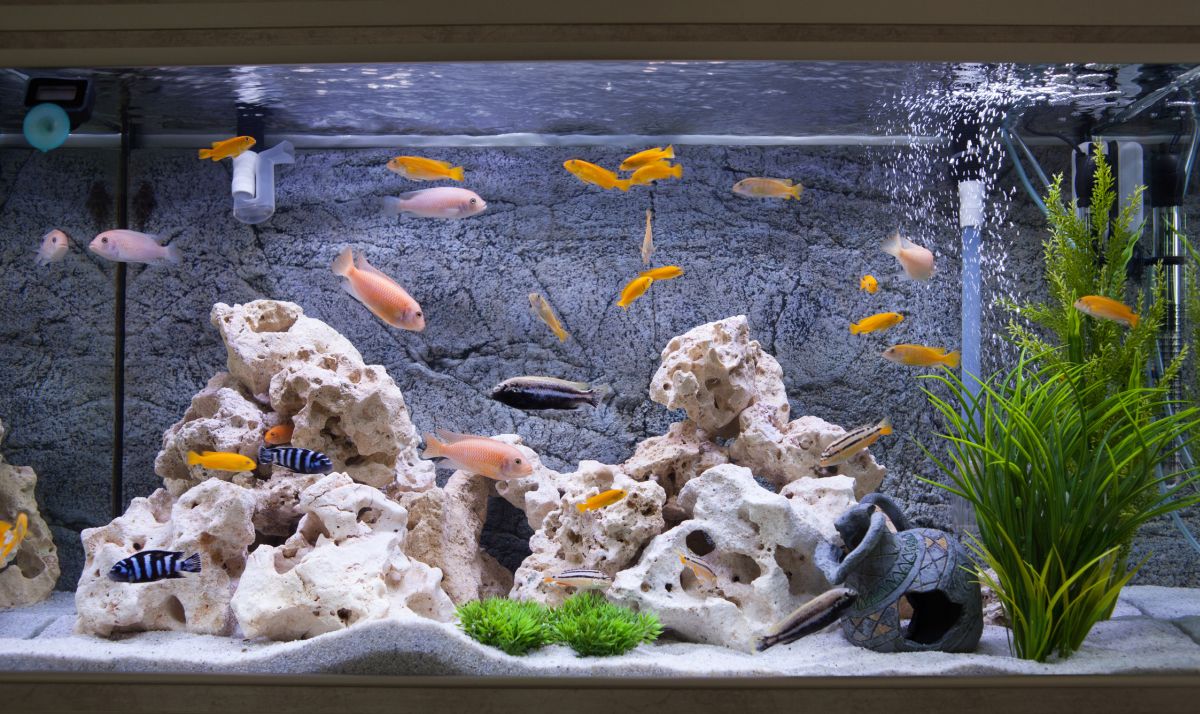What Rocks Raise pH in Aquarium?
Rocks can be used to raise pH levels in aquariums. The type of rock you use is important, as some rocks are more alkaline than others and will affect the pH differently. Limestone and dolomite are two types of rocks that can increase pH levels when placed in an aquarium.
These rocks contain calcium carbonate which reacts with water to create alkalinity, resulting in a higher pH level. Some other common aquarium rocks such as granite or basalt may have no effect on the pH level at all. It is important to research any new additions to your tank before adding them so you know what their effects will be on the environment for your fish and plants.
Rocks are a great way to naturally raise the pH level in an aquarium. Rocks, such as limestone and dolomite can be added directly to the tank or used in filter media with other materials like carbon or gravel. These rocks will slowly dissolve over time, releasing minerals that increase the alkalinity of your water.
This helps buffer sudden changes in pH which is important for maintaining proper water quality and keeping fish healthy.
How Much Limestone to Raise Ph in Aquarium
Adding limestone to an aquarium is a great way to raise the pH level, as it contains calcium carbonate which is known for its ability to buffer pH levels. In order to increase the pH of an aquarium, you should add 1-2 tablespoons of crushed limestone per 10 gallons of water. It’s important that you monitor the pH levels in your tank after adding limestone and make any necessary adjustments as needed.
Unsafe Rocks for Aquarium
It is important to note that while some rocks are safe for use in aquariums, others can be harmful. Unsafe rocks can leach minerals and chemicals into the water that may be toxic to fish or plants. Additionally, certain types of rock may have sharp edges which could injure fish or snag on their fins.
To ensure the safety of your aquatic environment, research any rock you plan to use before adding it to your tank.
Limestone Aquarium Rock for Sale
If you are looking to add a unique and natural look to your aquarium, then limestone aquarium rock might be the perfect addition! This type of rock is ideal for both freshwater and saltwater tanks and can provide an interesting aesthetic. It is also extremely durable and easy to clean, making it a great choice for any aquascaping project.
Limestone aquarium rocks can be found in many pet stores or online retailers at a reasonable price.
Aquarium Rocks That Don’T Raise Ph
Aquarium rocks that don’t raise pH are great for helping to maintain the level of acidity in your aquarium. These rocks have a neutral pH and won’t affect the water chemistry, making them ideal for any freshwater or saltwater tank. They can also be used to help create an aesthetically pleasing environment with their vibrant colors and shapes.
Limestone Aquarium Rocks
Limestone aquarium rocks can be a great addition to your tank, adding an interesting and unique aesthetic that can make your tank stand out. Limestone is a sedimentary rock composed mainly of calcium carbonate, making it ideal for buffering parameters in the water and helping to create an optimal environment for aquatic life. It’s also highly porous, which makes it a great place for beneficial bacteria to form colonies and help with biological filtration.
All in all, limestone aquarium rocks are both attractive and helpful when it comes to keeping your tank healthy!
Where to Buy Limestone for Aquarium
If you’re looking for a natural way to decorate your aquarium, consider buying limestone. Limestone is a sedimentary rock that is available in several shades of gray and provides an aesthetically pleasing backdrop for your fish tank. You can buy limestone online from specialty stores or pet supply retailers, or you may be able to find it locally at landscaping and stone suppliers.
When shopping for limestone, look for pieces with smooth edges that are free of cracks and blemishes so they won’t damage your tank’s glass walls.
How to Lower Ph in Aquarium
One of the most important things to monitor in an aquarium is its pH levels. In order to keep your aquarium healthy and balanced, it’s important to maintain a pH level between 6.5-7.0 for freshwater tanks, and 8.1-8.4 for saltwater tanks. If you find that your tank’s pH is too high (above 7), there are several steps you can take to lower it such as increasing aeration by adding a bubbler or air stone; using driftwood, peat moss, or special chemicals like sodium bicarbonate; or adding CO2 gas into the water with an injector system.
Does Limestone Raise Ph in Aquarium
Limestone can be a helpful tool to raise the pH in an aquarium. The calcium and carbonate found in limestone helps increase alkalinity, which in turn raises the pH of the water. It should not be used as a sole method to adjust pH levels, however, as too much limestone can result in cloudy water and other negative effects on tank inhabitants.
Adding small amounts of limestone at regular intervals is generally recommended for maintaining safe and stable pH levels.

Credit: www.buildyouraquarium.com
Do Rocks Raise Ph Level?
Rocks can have an effect on the pH level of a body of water. The most common type are limestone rocks, which contain calcium carbonate (CaCO3). When this mineral dissolves in water, it releases ions that raise the pH levels.
Limestone rocks typically occur in areas with high concentrations of dissolved minerals and organic matter such as rivers or streams. These rocks also often contain other minerals like magnesium, potassium, iron and sulfur which can all contribute to raising the pH levels even further. In addition to freshwater sources, limestone is also found in saltwater environments where its effects can be seen on coral reefs and other aquatic life forms.
Overall, it has been shown that when limestone rocks are introduced into a body of water they will increase its overall pH level due to their chemical composition and release of bicarbonates into the environment.
What Aquarium Rocks Won’T Raise Ph?
Aquarium rocks play an important role in providing a healthy environment for fish and other aquatic life, but not all rocks are created equal. It’s important to choose the right type of rock for your aquarium because some can raise pH levels too high, putting stress on your tank inhabitants. Fortunately, there are several types of aquarium rocks that won’t raise pH levels: volcanic rock such as basalt or pumice; quartzite; granite; tufa rock; sandstone and certain limestones.
Each of these types of rocks is safe to use in aquariums and they will not increase the water’s alkalinity or pH level. However, it is still important to monitor the water parameters regularly to ensure that everything remains balanced. Additionally, you should always rinse any new rocks thoroughly before placing them into your tank so as not to introduce potentially harmful chemicals or contaminants into the water.
With careful selection and proper maintenance, using these sorts of non-pH raising aquarium rocks can help create a beautiful living landscape while helping keep your fish happy and healthy!
What Causes Ph to Rise in Aquarium?
The pH of an aquarium is a measure of how acidic or alkaline the water is and can have a big impact on the health of your fish. A pH level that is too low (acidic) or too high (alkaline) can cause problems in your tank, so it’s important to keep an eye on it. But what causes pH levels to rise in an aquarium?
There are several possible reasons, such as increased carbon dioxide levels, overfeeding, and changes in water temperature. Carbon dioxide from respiration by fish and other aquatic organisms will increase acidity if there isn’t enough oxygen present for them to use instead. Overfeeding can also lead to more waste being produced than the filter system can handle which leads to higher levels of ammonia which makes the water more alkaline.
Finally, even small increases in temperature can affect the ability of some species’ gills to absorb oxygen properly leading to reduced aeration and thus higher pH values overall.
Will Air Stone Raise Ph?
When it comes to the question of whether air stone will raise pH, the answer is yes – but only in a limited capacity. Air stones are typically used for aeration purposes in aquariums and ponds; when air bubbles pass through water, they create tiny pockets of oxygen which can help increase dissolved oxygen levels. This increase in dissolved oxygen also has an effect on pH; as more oxygen enters the tank, certain bacteria will start to grow and release compounds like carbon dioxide into the water that can lower its acidity level (pH).
So while having an air stone installed won’t necessarily result in a dramatic shift towards higher alkalinity or basicity levels, it can have a noticeable impact on your tank’s overall chemistry over time. It’s important to note that this isn’t always desirable – if you already have overly high alkaline levels then adding additional sources of aeration might not be advisable as this could cause even further shifts away from optimal conditions. However, if you find yourself with low pH values then an air stone would definitely provide some benefit!
How to raise Water PH? Why does it matter?
Conclusion
In conclusion, it is clear that aquarium rocks can be used to raise the pH of an aquarium. Rocks such as limestone and coral rock are both effective in raising the pH levels in a tank, although limestone is preferable due to its availability and affordability. Additionally, there are other methods available for managing pH levels such as adding baking soda or using chemical buffers.
Therefore, it is important to research which method will best suit your particular needs before making any changes to your tank’s water parameters.



